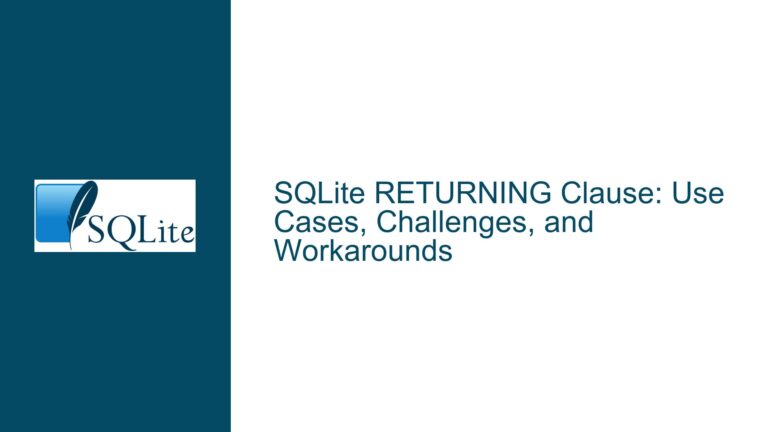Identifying Tail Numbers with Multiple Airlines in SQLite Flight Database
Schema Design & Query Logic for Multi-Airline Tail Number Detection
Data Model & Join Type Implications in Airline-Tail Number Relationships
The core challenge involves detecting TAIL_NUMBER values linked to multiple AIRLINE entries through their shared IATA_CODE_AIRLINE identifier. This requires analyzing the relationship between the Originalflightdata table (containing flight records with tail numbers and airline codes) and the airlines table (mapping IATA codes to airline names).
1. Table Structure Assumptions
- Originalflightdata schema:
TAIL_NUMBER(text): Unique aircraft identifierIATA_CODE_AIRLINE(text): Airline operator code
- airlines schema:
IATA_CODE(text): Primary key matchingIATA_CODE_AIRLINEAIRLINE(text): Full airline name
A critical assumption here is that IATA_CODE_AIRLINE in Originalflightdata corresponds directly to IATA_CODE in airlines. If this foreign key relationship isn’t enforced (common in SQLite without explicit constraints), orphaned IATA_CODE_AIRLINE values could exist, leading to NULL airline names when joined.
2. Join Type Misapplication: LEFT vs. INNER
The original query uses LEFT JOIN, which preserves all rows from Originalflightdata even if no matching airlines entry exists. This introduces two risks:
- False Positives: Tail numbers with invalid/missing
IATA_CODE_AIRLINEvalues appear with NULL airlines, erroneously suggesting multiple airlines if other valid entries exist. - Unnecessary Data Retrieval: Including non-matching rows increases result set size and complicates aggregation.
Switching to INNER JOIN ensures only valid IATA_CODE_AIRLINE values contribute to airline counts, as unmatched rows are excluded. This aligns with the goal of detecting actual airline associations rather than data entry errors.
Aggregation Errors & Filtering Logic in GROUP BY Queries
The initial attempt to filter tail numbers with multiple airlines failed due to syntax and logic flaws in aggregation.
1. WHERE vs. HAVING Clause Misplacement
The erroneous query:
SELECT ... GROUP BY TAIL_NUMBER WHERE COUNT(...) > 1
violates SQL syntax rules because:
- WHERE filters rows before aggregation.
- HAVING filters grouped results after aggregation.
Using WHERE COUNT(...) > 1 attempts to filter non-existent aggregated values during row selection. Correcting this to HAVING COUNT(...) > 1 resolves the syntax error but introduces another issue:
2. Non-Distinct Counts in Multi-Join Scenarios
The query:
SELECT TAIL_NUMBER, AIRLINE
FROM Originalflightdata
LEFT JOIN airlines ...
GROUP BY TAIL_NUMBER
HAVING COUNT(TAIL_NUMBER) > 1
counts all rows per tail number, including duplicates from the join. If a tail number has multiple flights with the same airline, COUNT(TAIL_NUMBER) exceeds 1 even if the airline is unique.
Example:
- Tail N123 has 5 flights with airline AA.
COUNT(TAIL_NUMBER)= 5 → Incorrectly flagged as multi-airline.
Solution: Use COUNT(DISTINCT airlines.IATA_CODE) to count unique airlines per tail number.
Step-by-Step Resolution: Subqueries, Join Optimization & Validation
1. Isolate Tail Numbers with Multiple Airlines
First, identify tail numbers with ≥2 distinct airlines using a subquery:
SELECT TAIL_NUMBER
FROM Originalflightdata
GROUP BY TAIL_NUMBER
HAVING COUNT(DISTINCT IATA_CODE_AIRLINE) > 1;
Key Points:
- Excludes joins to avoid complexity.
DISTINCTensures multiple airlines, not multiple flights.
2. Retrieve Full Details for Affected Tail Numbers
Use the subquery result to filter the main dataset:
SELECT F.TAIL_NUMBER, F.IATA_CODE_AIRLINE, A.AIRLINE
FROM Originalflightdata F
INNER JOIN airlines A ON F.IATA_CODE_AIRLINE = A.IATA_CODE
WHERE F.TAIL_NUMBER IN (
SELECT TAIL_NUMBER
FROM Originalflightdata
GROUP BY TAIL_NUMBER
HAVING COUNT(DISTINCT IATA_CODE_AIRLINE) > 1
)
ORDER BY F.TAIL_NUMBER, F.IATA_CODE_AIRLINE;
Optimizations:
- INNER JOIN: Drops invalid/unmatched IATA codes.
- Subquery Efficiency: Filters early, reducing join workload.
3. Validate with Sample Data
Testing with controlled data prevents false positives/negatives:
CREATE TABLE Originalflightdata (TAIL_NUMBER TEXT, IATA_CODE_AIRLINE TEXT);
INSERT INTO Originalflightdata VALUES
('A102', 'AA'), ('A102', 'DL'), -- Multi-airline
('B999', 'UA'), ('B999', 'UA'); -- Single-airline
CREATE TABLE airlines (IATA_CODE TEXT, AIRLINE TEXT);
INSERT INTO airlines VALUES
('AA', 'American Airlines'),
('DL', 'Delta Air Lines'),
('UA', 'United Airlines');
-- Run the final query
Expected Output:
| TAIL_NUMBER | IATA_CODE_AIRLINE | AIRLINE |
|---|---|---|
| A102 | AA | American Airlines |
| A102 | DL | Delta Air Lines |
B999 is excluded despite two flights because both are with United Airlines.
Advanced Considerations & Edge Cases
1. Handling NULL IATA Codes
If Originalflightdata.IATA_CODE_AIRLINE contains NULLs:
COUNT(DISTINCT IATA_CODE_AIRLINE)treats NULL as a unique value.- Tail numbers with NULL and a valid code would be counted as two airlines.
Mitigation: Add WHERE IATA_CODE_AIRLINE IS NOT NULL to the subquery.
2. Performance with Large Datasets
- Indexing: Add indexes on
TAIL_NUMBERandIATA_CODE_AIRLINEfor faster grouping. - Materialized Views: Precompute multi-airline tail numbers if query frequency is high.
3. Alternative Using Window Functions
SQLite 3.25+ supports window functions for a single-pass solution:
SELECT TAIL_NUMBER, IATA_CODE_AIRLINE, AIRLINE
FROM (
SELECT
F.TAIL_NUMBER,
F.IATA_CODE_AIRLINE,
A.AIRLINE,
COUNT(DISTINCT F.IATA_CODE_AIRLINE) OVER (PARTITION BY F.TAIL_NUMBER) AS airline_count
FROM Originalflightdata F
INNER JOIN airlines A ON F.IATA_CODE_AIRLINE = A.IATA_CODE
)
WHERE airline_count > 1
ORDER BY TAIL_NUMBER;
Advantage: Avoids subquery nesting; may improve readability.
Final Recommendations
- Use INNER JOIN Unless NULLs Are Intentional: Ensure joins reflect actual business logic.
- Always Test with Edge Cases: Include multi-airline, single-airline, and NULL scenarios.
- Index Critical Columns: Speed up grouping and filtering operations.
- Document Assumptions: Note whether IATA codes are enforced as foreign keys.
By methodically addressing schema design, join logic, aggregation filtering, and validation, this approach reliably identifies tail numbers associated with multiple airlines while avoiding common SQL pitfalls.






